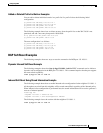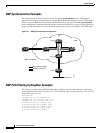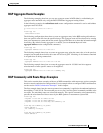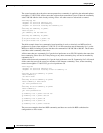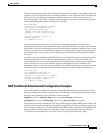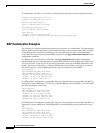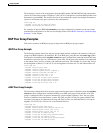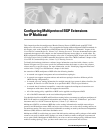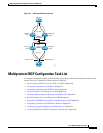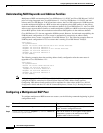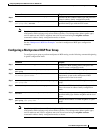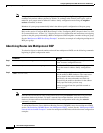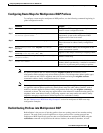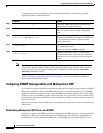
IPC-347
Cisco IOS IP Configuration Guide
Configuring Multiprotocol BGP Extensions
for IP Multicast
This chapter describes the multiprotocol Border Gateway Protocol (BGP) based upon RFC 2283,
Multiprotocol Extensions for BGP-4. For a complete description of the multiprotocol BGP commands in
this chapter, refer to the “Multiprotocol BGP Extensions for IP Multicast Commands” chapter of the
Cisco IOS IP Command Reference, Volume 2 of 3: Routing Protocols. To locate documentation for other
commands that appear in this chapter, use the command reference master index, or search online. For
BGP configuration information and examples, refer to the “Configuring BGP” chapter of the Cisco IOS
IP Configuration Guide. For BGP command descriptions, refer to the “BGP Commands” chapter of the
Cisco IOS IP Command Reference, Volume 2 of 3: Routing Protocols.
To identify the hardware platform or software image information associated with a feature, use the
Feature Navigator on Cisco.com to search for information about the feature or refer to the software
release notes for a specific release. For more information, see the “Identifying Supported Platforms”
section in the “Using Cisco IOS Software” chapter in this book.
An extension of BGP, multiprotocol BGP offers the following benefits:
• A network can support incongruent unicast and multicast topologies.
• A network can support congruent unicast and multicast topologies that have different policies
(BGP filtering configurations).
• A network can carry routing information for multiple network layer protocol address families (for
example, IP Version 4 or VPN Version 4) as specified in RFC 1700, Assigned Numbers.
• A network that is backward compatible—routers that support the multiprotocol extensions can
interoperate with routers that do not support the extensions.
• All of the routing policy capabilities of BGP can be applied to multiprotocol BGP.
• All of the BGP commands can be used with multiprotocol BGP.
You should be familiar with BGP and IP multicast routing before you attempt to configure multiprotocol
BGP. For IP multicast configuration information and examples, refer to the “IP Multicast” part of this
document and Cisco IOS IP Command Reference, Volume 3 of 3: Multicast.
Multiprotocol BGP is an enhanced BGP that carries routing information for multiple network layer
protocols and IP multicast routes. BGP carries two sets of routes, one set for unicast routing and one set
for multicast routing. The routes associated with multicast routing are used by the Protocol Independent
Multicast (PIM) feature to build data distribution trees.
Multiprotocol BGP is useful when you want a link dedicated to multicast traffic, perhaps to limit which
resources are used for which traffic. Perhaps you want all multicast traffic exchanged at one network
access point (NAP). Multiprotocol BGP allows you to have a unicast routing topology different from a
multicast routing topology. Thus, you have more control over your network and resources.



